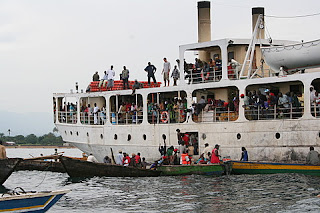On Sunday 28 January we boarded the Liemba heading north for the village of Lagosa. As there is no dock in Kipili, one of our small, wooden boats took us from the island to where the ship had moored in the Kipili bay. Our boat was then lashed onto the Liemba and we passed our luggage through the 1.5m x 1.5m square hole in the side of the boat which acts as the entrance for goods and passengers alike. Once our bags were onboard we climbed through the hole ourselves and found that we were in the bowels of the boat.
This turned out to be the third class area of the boat. Here passengers do not pay for individual cabins, instead tables and benches were used as beds. The overhead luggage racks were overflowing with bags of clothes and food. Those passengers who were not so lucky found a quiet area in a corner and slept on their bags or on top of the sacks of fish, rice and maize meal that were being transported on the ship. The colourful scene included people selling biscuits, long life milk, sugar and bread, women changing their babies and of course, the deafening din of an out of tune, “over-volumed” radio. After paying for our VIP cabin, we were allowed upstairs to the top deck and shown to our room.
The VIP cabin is the only room on board the Liemba, which has its own en-suite bathroom with toilet, basin and shower (with hot water too). Thank goodness it also had a fan mounted to the ceiling, because this ensured that we had a relatively comfortable night’s sleep.
Enroute to Lagosa, which is on the northern most point of the Mahale Mountains National Park, we stopped at 5 small villages at allow passengers and goods to get onto and off the ship. Small fishing style boats, some with engines, come alongside the Liemba, and tied themselves to the ship and to one another. The goods were then passed from one boat to the next and then into the Liemba through the square hole. This sounds relatively easy and orderly, but when the lake is rough, it is anything but simple. Frightened children were hoisted from the small boats by their arms onto the Liemba, heavy bags of maize were pulled up through the boat’s entrance hole and chickens were thrown unceremoniously onboard. It was a spectacle that I will never forget.
This photograph shows the smaller fishing boats alongside the Liemba, waiting to transport passengers and cargo back to the mainland.


















































